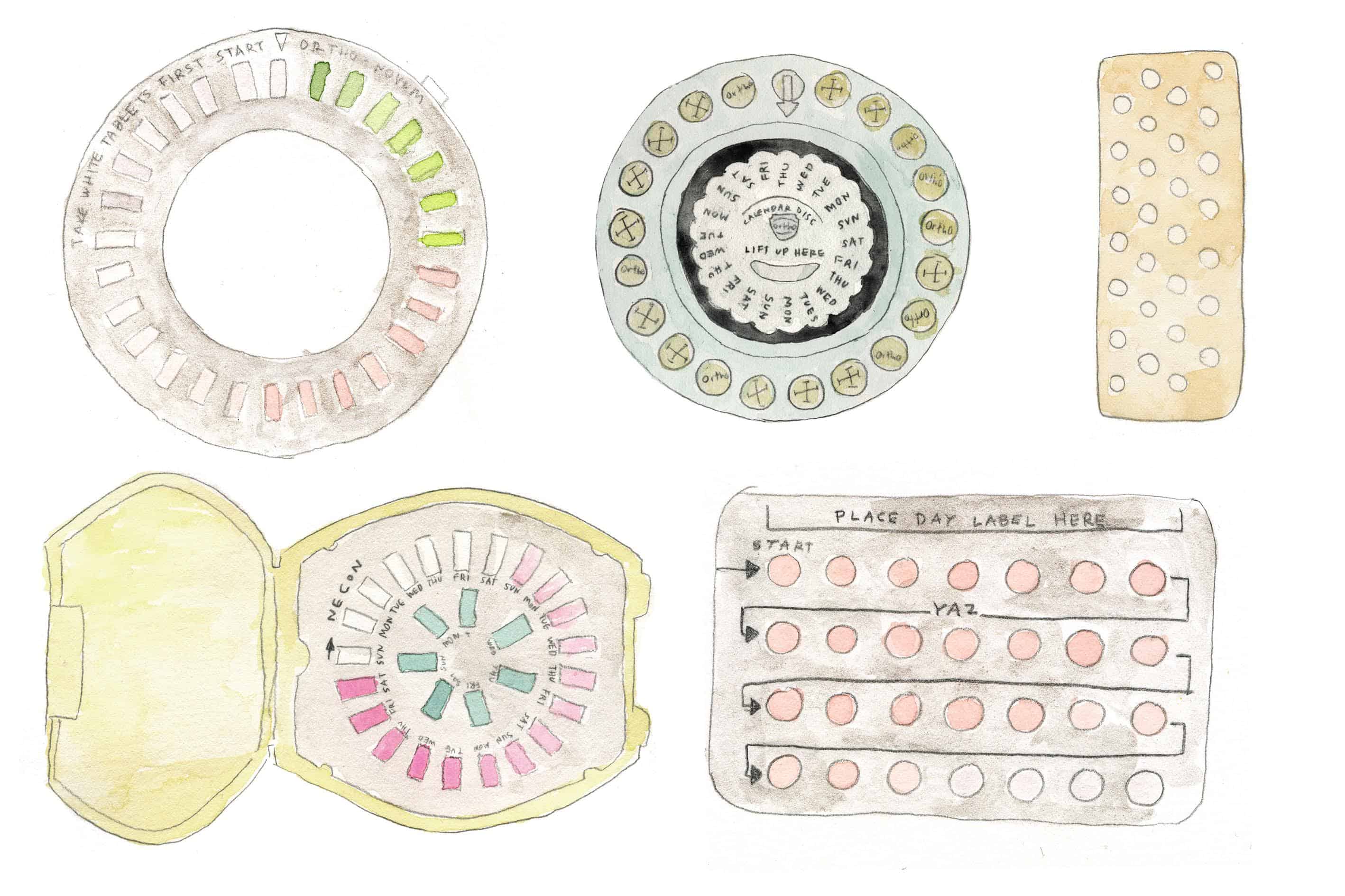
History Lesson: The Birth Control Pill
Written by Katie Hintz-Zambrano
Photography by Illustration by Alessandra Olanow
Oh, The Pill. More fancifully called the combined oral contraceptive pill (COCP), this little nugget containing a mix of estrogen and progestogen has not only helped women take their reproductive future into their own hands, it’s changed the very foundation of culture and steered the course of women’s history in every community it’s touched. So, we only thought it right to take a brief stroll down memory lane and a look at the roots of these little packets of power.
Way, Way Back: In Ancient Egypt, women use a suppository made of cotton, dates, honey, and acacia (which, in fermented form, has a spermicidal effect) to prevent pregnancy. Other less useful methods include a mix of honey, sodium carbonate, and crocodile dung (Egypt), a mercury and lead drink (Ancient China), holding ones breath during and sneezing after intercourse (Ancient Greece), jumping backwards 7-9 times to dislodge sperm (10th Century Persia), and accessorizing oneself with a weasel’s testicles during sex (seriously, Middle Ages Europe). Meanwhile, both the Old Testament and the Koran refer loosely to what’s now dubbed “the withdrawal method.” A 15,000-year-old French cave painting illustrating condom use was also found.
1873: In Anthony Comstock’s crusade against “obscenity,” the Comstock Act is passed, banning the spread of information about contraceptives in the U.S. (even from doctors).
1916: Feminist and family planning advocate Margaret Sanger, who coined the word “birth control,” opens up the first “birth control clinic” in Brooklyn. Ten days later, it’s closed down by the New York Vice Squad, who arrest her for distributing information on contraception.
1921: Sanger founds the American Birth Control League, which later becomes Planned Parenthood. For the next two decades, she opens up multiple centers and helps physicians gain the right to counsel patients on contraceptive methods and family planning services.
1925: The first diaphragms are manufactured in the U.S.
1937: The American Medical Association endorses the idea of “birth control.” North Carolina becomes the first state to add it to its public health program.
1951: Sanger and endocrinologist Gregory Pincus start working on a birth control pill. At the same time, Mexico-based chemist Carl Djerassi creates the very first birth control pill by synthesizing hormones from yams. However, he doesn’t have the ability to produce and distribute it.
1953: After promising lab results using progesterone on rats, Pincus is given $40,000 by activist and heiress Katherine McCormick to continue his research. A year later, Pincus and gynecologist John Rock try their pill on 50 women in Massachusetts with great success.
1956: With anti-birth control laws in effect in the U.S., clinical trials head to Puerto Rico. The pill is labeled 100% effective, with some side effects. A year later, it’s approved by the FDA, but only to treat severe menstrual disorders, like PMS or irregular periods (which women start reporting in dubiously high numbers).
1957: The average number of children per family peaks at 3.7 (from 3.5 children in 1900).
1960: The FDA approves the Enovis pill (as well as the intrauterine device) as a contraceptive. Within five years, 6.5 million American women are using the pill, although it’s not legal in all the states, and is shunned by the Catholic Church.
1965: The Supreme Court strikes down state laws prohibiting contraceptives used by married couples. The pill becomes the most popular birth control method, followed by the condom and contraceptive sterilization.
1969: The Doctor’s Case Against The Pill is published, and sheds light on some of the pill’s health risks—from heart attack and stroke to depression and loss of libido. A year later, the Senate holds controversial hearings about the pill’s safety and requires manufacturers to include information about the risks associated with the pill with each bottle—a first for any prescription drug. Over the next ten years, sales slide by 24%.
1972: The birth control pill is deemed legal for both married and unmarried couples in all the states. This same year, the average number of children per family levels off to approximately 2.
1988: The original pill (containing a high amount of estrogen) is taken off the market, replaced with new pills that tout benefits like a decreased risk of ovarian cancer, iron deficiency anemia, and pelvic inflammatory disease.
1993: The female condom is approved by the FDA.
1997: The FDA approves Tri-Cyclen for the treatment of acne.
2000: It’s now the law that employee health insurance must cover prescription birth control pills.
2003: Seasonale, a pill giving women only four periods a year, is approved. Four years later, the Lybrel pill eliminates periods all together.
2011: Over 1,000 lawsuits against the maker of Yaz, Yazmin, and Ocella are pending, due to serious health issues allegedly triggered by these pills, including nearly 100 deaths.
2014: IUD’s and other implantable contraceptions are shown to be 10 to 100 times more effective than birth control pills in preventing unwanted pregnancies, and are likely to become the first choice for teens—and adults—looking for reliable contraception.
2015: A whopping 99% of American women of childbearing age report using some form of contraception at one time or another. And more than 100 million women around the world use the pill.
Resources: PBS, The Atlantic, Centers for Disease Control * Prevention, Time, USA Today, and Drug Watch.
Share this story



